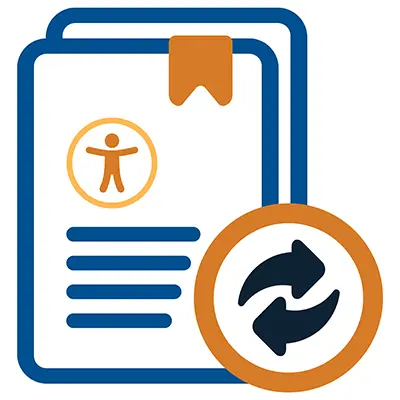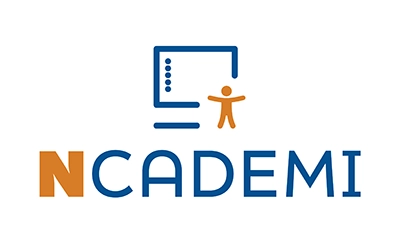
Statement
State and local educational agencies (SEA and LEAs) follow guidelines with deliberate actions to ensure accessibility is embedded in all components of edtech procurement—from initial bidding through product selection and contracting.
Intent
Agencies consider a range of factors in the edtech procurement process. The intent of Quality Indicator DM2 is to ensure all edtech solutions, including assessments, are accessible for students with disabilities. Processes for evaluating and vetting edtech applications and products include clearly defined accessibility criteria. Contracts with vendors include accountability for current and future product accessibility. The SEA leads by modeling these guidelines, which can be adopted or adapted by LEAs.
Critical Components
To effectively address Quality Indicator DM2, the following components should be present:
DM2.1 Accessibility in Procurement Processes
Procurement tools and resources used by the agency embed accessibility as a requirement of the bidding process.
- Requests for Information (RFI)/Requests for Proposals (RFP) explicitly reference Web Content Accessibility Guidelines (WCAG) 2.1 Level AA as the accessibility standard.
- Accessibility criteria are integrated into the product scoring system at the same level of importance as other requirements.
- Contracts, purchase agreements, memoranda of understanding, or other similar documents include language holding the vendor to account for claims regarding product accessibility, including the commitment to continuous improvements documented within an accessibility roadmap.
DM2.1 Self-Assessment Scoring Matrix
| Not Started | Emerging | Operationalizing | Scaling & Sustainability |
|---|---|---|---|
| The inclusion of digital accessibility requirements in procurement tools and resources has not yet been considered. | The SEA and LEAs (“the agency”) are reviewing current procurement tools (e.g., RFP templates, scoring rubrics, contract language) to identify gaps related to accessibility. Staff are learning about WCAG 2.1 Level AA (or a higher standard) and best practices for embedding accessibility into bidding processes. Planning is underway to update procurement documents. | All of the agency’s RFIs/RFPs include WCAG 2.1 Level AA (or a higher standard). Product evaluation rubrics begin to include accessibility criteria. Contract templates include some accessibility terms, and vendors are beginning to be asked about accessibility roadmaps. The agency is beginning to align tools across departments. | All of the agency’s procurement tools and resources (RFI/RFP, scoring rubrics, contracts) include WCAG 2.1 Level AA (or a higher standard) as a non-negotiable requirement. Accessibility is weighted proportionately with other major product criteria. Contracts include enforceable clauses holding vendors accountable for accessibility claims and continuous improvement, tied to an accessibility roadmap. All procurement tools and resources are routinely reviewed and updated to stay current with accessibility standards and best practices. |
The scoring matrix is part of the Quality Indicator Self-Assessment Tools.
DM2.2 Vendor Demonstration Requirement
The agency requires vendors to demonstrate evidence of product accessibility.
- A third-party Accessibility Conformance Report (ACR), based on the Voluntary Product Accessibility Template (VPAT®), is used to disclose product conformance to WCAG standards.
- Responses to the following questions are used to measure vendor accessibility maturity:
- Who is your organizational contact for product accessibility questions?
- What internal training does your organization provide to build capacity for producing accessible products?
- What processes and workflows does your organization use to ensure accessibility is embedded in all phases of product design and development?
- What tools does your organization use to ensure that design and development teams are integrating accessibility in production?
- An accessibility-specific demonstration by the vendor shows how the product works with common assistive technology used by students with disabilities without relying on an accessibility overlay.
DM2.2 Self-Assessment Scoring Matrix
| Not Started | Emerging | Operationalizing | Scaling & Sustainability |
|---|---|---|---|
| The need for vendors to demonstrate product accessibility has not yet been considered. | The SEA and LEAs (“the agency”) are identifying expectations for vendor-provided evidence. Staff are learning how to review ACRs, draft maturity questions, and observe accessibility demonstrations. Planning is underway to include these requirements in procurement processes. Conversations are occurring across teams (e.g., IT, instruction, procurement) about feasibility and alignment. | The agency requires ACRs for some digital product procurements and requests maturity responses for high-priority tools. Accessibility demos are piloted with select vendors to evaluate product behavior with assistive technology. Some staff are trained to interpret ACRs and evaluate vendor responses. Findings are used to inform procurement decisions. | ACRs, maturity responses, and assistive technology demonstrations are standard requirements in all agency procurements. The agency has trained reviewers who evaluate evidence, ask follow-up questions, and identify reliance on accessibility overlays. Results are documented, inform purchasing decisions, and help the agency track vendor performance over time. |
DM2.3 Accessibility Evaluation
The agency conducts direct testing to evaluate for accessibility.
- Testing conducted by a native assistive technology user, trained staff member, or trusted contractor.
- The extent of the testing (full/partial, manual/automatic) is dependent on the sufficiency of accessibility documentation and evidence provided by the vendor.
DM2.3 Self-Assessment Scoring Matrix
| Not Started | Emerging | Operationalizing | Scaling & Sustainability |
|---|---|---|---|
| The need to test products for accessibility in the procurement process has not yet been considered. | The SEA and LEAs (“the agency”) are learning about different testing methods (automated, manual, assistive technology-based) and determining when direct testing is needed. Potential testers (e.g., trained staff, AT users, contractors) are being identified. Internal protocols for how testing will complement vendor evidence are being developed. | The agency conducts direct testing for select procurements, especially when vendor documentation is insufficient. Testing is carried out by trained internal staff or external partners. Testing depth varies based on risk and product use. Results begin to inform decision-making and vendor feedback. Resources and protocols are under refinement. | The agency has a routine process for conducting or commissioning accessibility testing that complements vendor documentation. Testing is performed by experienced users of assistive technology, trained accessibility evaluators, or qualified contractors. Results are documented, communicated to vendors, and used to inform procurement decisions and improvement plans. |
